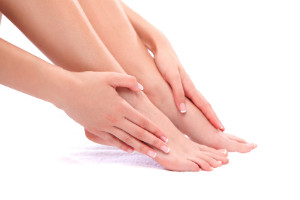Blog
Reflexology Has Numerous Benefits
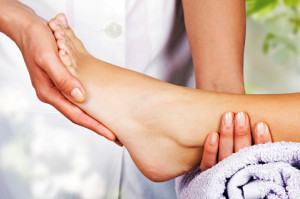
Reflexology is a popular form of foot therapy. This type of therapy focuses on pressing on specific reflex points on the foot, and many people find it to be relaxing. It is known to balance energy in the body, and patients may find this helps to maintain well-being. Organs and certain areas of the body are connected to these points and can invoke a healing response. Some of the benefits that are associated with reflexology can include boosting the immune system, increasing circulation, and cleansing the body of toxins. Additionally, some people have noticed existing headaches, sinus conditions, and stomach pains may be reduced when reflexology is practiced. Healing may occur to organs that need it, and the overall body may become stronger when the entire foot is massaged. If you are interested in learning more about foot reflexology, it is suggested that you confer with a podiatrist who can answer any questions you may have.
Foot therapy is often necessary for those recovering from either foot deformities or foot injuries. If you have concerns regarding therapy, consult with one of our podiatrists from Westside Podiatry Center, LLP. Our doctors can provide the care you need to keep you pain-free and on your feet.
Most Common Injuries
People who are active or athletes are prone to a variety of injuries. Therefore, it is often important to take part in physical therapy in order to quickly get back on the right track.
What to Do When Injured
Physical Therapy – This specialized treatment will focus on the affected area, speeding up recovery and the overall healing process. It is a proven method that has helped millions of people return from any injury.
During physical therapy you will undergo regimented training to get back into full form. Training is often very difficult, especially at first when the foot feels weak. Physical therapy often involves:
Basic stretching and twisting exercises – getting the feet’s mobility and flexibility up.
Massaging – the therapist will massage the injured area in order to activate the muscles and relax them.
Strengthening Exercises – this allows the muscles in the affected area to regain their full strength, a vital step towards full recovery.
If you have any questions please feel free to contact one of our offices located in Liverpool, Camillus, Skaneateles, Oswego, and Cicero, NY . We offer the newest diagnostic tools and technology to treat your foot and ankle needs.
Do Your Child's Feet Hurt?
Simple Habits for Everyday Foot Care

Many people take their feet for granted, even though they are the foundation of the body. The feet will feel better when everyday foot care methods are routinely applied, which can begin with washing and drying the feet thoroughly. This can be followed by using a good moisturizer and trimming the toenails once per week. It is beneficial to cut the toenails straight across instead of in a curved fashion, and this may be helpful in preventing an ingrown toenail from developing. When the skin on the feet is regularly exfoliated, the removal of dead skin can make them feel softer. Exfoliating can be accomplished using a pumice stone, and it can help to soak the feet in warm water before beginning this procedure. It is beneficial to wear shoes that fit correctly, which can help to prevent several uncomfortable foot conditions from developing. If you would like more information about successful everyday foot care tips, it is suggested that you confer with a podiatrist who can provide you with the knowledge you are seeking.
Everyday foot care is very important to prevent infection and other foot ailments. If you need your feet checked, contact one of our podiatrists from Westside Podiatry Center, LLP. Our doctors can provide the care you need to keep you pain-free and on your feet.
Everyday Foot Care
Often, people take care of their bodies, face and hair more so than they do for their feet. But the feet are a very important aspect of our bodies, and one that we should pay more attention to. Without our feet, we would not be able to perform most daily tasks.
It is best to check your feet regularly to make sure there are no new bruises or cuts that you may not have noticed before. For dry feet, moisturizer can easily be a remedy and can be applied as often as necessary to the affected areas. Wearing shoes that fit well can also help you maintain good foot health, as well as making it easier to walk and do daily activities without the stress or pain of ill-fitting shoes, high heels, or even flip flops. Wearing clean socks with closed shoes is important to ensure that sweat and bacteria do not accumulate within the shoe. Clean socks help to prevent Athlete’s foot, fungi problems, bad odors, and can absorb sweat.
If you have any questions please feel free to contact one of our offices located in Liverpool, Camillus, Skaneateles, Oswego, and Cicero, NY . We offer the newest diagnostic and treatment technologies for all your foot and ankle needs.
Can a Child Get a Hammertoe?

A hammertoe is a toe deformity where the toe is bent downward at the joint, resembling a hammer. This can happen in children because of a congenital disability, wearing shoes that do not fit well, or pressure from a bunion. Buying comfortable shoes with the right size and a wide enough toe box for the toes to spread out is critical. Using a corn pad to protect the hammertoe can help relieve pressure and discomfort from friction within shoes. A child with a hammertoe can also benefit from stretching their toe muscles throughout the day. It is important to treat this condition in children to prevent future foot problems. If your child has a hammertoe, it is strongly suggested that you visit a podiatrist who can provide a plan of treatment to ease pain, correct the deformity, and protect their feet from developing further issues.
Hammertoe
Hammertoes can be a painful condition to live with. For more information, contact one of our podiatrists from Westside Podiatry Center, LLP. Our doctors will answer any of your foot- and ankle-related questions.
Hammertoe is a foot deformity that affects the joints of the second, third, fourth, or fifth toes of your feet. It is a painful foot condition in which these toes curl and arch up, which can often lead to pain when wearing footwear.
Symptoms
- Pain in the affected toes
- Development of corns or calluses due to friction
- Inflammation
- Redness
- Contracture of the toes
Causes
Genetics – People who are genetically predisposed to hammertoe are often more susceptible
Arthritis – Because arthritis affects the joints in your toes, further deformities stemming from arthritis can occur
Trauma – Direct trauma to the toes could potentially lead to hammertoe
Ill-fitting shoes – Undue pressure on the front of the toes from ill-fitting shoes can potentially lead to the development of hammertoe
Treatment
Orthotics – Custom made inserts can be used to help relieve pressure placed on the toes and therefore relieve some of the pain associated with it
Medications – Oral medications such as anti-inflammatories or NSAIDs could be used to treat the pain and inflammation hammertoes causes. Injections of corticosteroids are also sometimes used
Surgery – In more severe cases where the hammertoes have become more rigid, foot surgery is a potential option
If you have any questions please contact one of our offices located in Liverpool, Camillus, Skaneateles, Oswego, and Cicero, NY . We offer the newest diagnostic and treatment technologies for all your foot and ankle needs.
What Can Cause Poor Circulation?

Having cold feet may be a symptom of poor circulation. Feet may also become numb and discolored, and there are various reasons for this condition to happen. Existing medical ailments, such as Raynaud’s disease may lead to developing poor circulation. Having acrocyanosis, which turns the feet or toes blue, may be another reason for this to occur. This condition can cause the blood vessels to constrict, and blood is prevented from moving through the feet. Patients who have diabetes often have poor circulation, and immediate medical attention is often sought that may help to prevent diabetic foot ulcers from developing. Additionally, smoking, high blood pressure and elevated cholesterol levels may cause poor circulation. There are methods that can be implemented which may help to reduce the risk. These can include performing breathing exercises, practicing meditation, and yoga, in addition to avoiding alcohol and caffeine. If you have symptoms of poor circulation, it is suggested that you confer with a podiatrist who can properly treat this condition.
Poor circulation is a serious condition and needs immediate medical attention. If you have any concerns with poor circulation in your feet contact one of our podiatrists of Westside Podiatry Center, LLP. Our doctors will treat your foot and ankle needs.
Poor Circulation in the Feet
Poor blood circulation in the feet and legs is can be caused by peripheral artery disease (PAD), which is the result of a buildup of plaque in the arteries.
Plaque buildup or atherosclerosis results from excess calcium and cholesterol in the bloodstream. This can restrict the amount of blood which can flow through the arteries. Poor blood circulation in the feet and legs are sometimes caused by inflammation in the blood vessels, known as vasculitis.
Causes
Lack of oxygen and oxygen from poor blood circulation restricts muscle growth and development. It can also cause:
- Muscle pain, stiffness, or weakness
- Numbness or cramping in the legs
- Skin discoloration
- Slower nail & hair growth
- Erectile dysfunction
Those who have diabetes or smoke are at greatest risk for poor circulation, as are those who are over 50. If you have poor circulation in the feet and legs it may be caused by PAD and is important to make changes to your lifestyle in order to reduce risk of getting a heart attack or stroke. Exercise and maintaining a healthy lifestyle will dramatically improve conditions.
As always, see a podiatrist as he or she will assist in finding a regimen that suits you. A podiatrist can also prescribe you any needed medication.
If you have any questions please feel free to contact one of our offices located in Liverpool, Camillus, Skaneateles, Oswego, and Cicero, NY . We offer the newest diagnostic and treatment technologies for all your foot and ankle needs.
What Causes the Seeds in Seed Warts?

A seed wart can result when an individual comes into direct contact with the human papillomavirus, or HPV. This skin growth can be quite unsightly and typically forms on the bottom, or sole, of the foot. They are characterized by the presence of very small black dots, known as seeds, in the center of the wart. Interestingly, these seeds are not really seeds in the traditional use of the word. Rather, these seeds are actually just tiny blood vessels that have become clotted. Therefore, although these tiny dots might look like seeds, they are in fact just blood vessels. The virus that causes seed warts is extremely contagious and can be spread by skin-to-skin contact and by other means. If you are someone that may have a seed wart, it is strongly suggested that you schedule an appointment with a podiatrist as quickly as possible who can analyze and address your foot problem.
Plantar warts can be very uncomfortable. If you need your feet checked, contact one of our podiatrists from Westside Podiatry Center, LLP. Our doctors will assist you with all of your foot and ankle needs.
About Plantar Warts
Plantar warts are the result of HPV, or human papillomavirus, getting into open wounds on the feet. They are mostly found on the heels or balls of the feet.
While plantar warts are generally harmless, those experiencing excessive pain or those suffering from diabetes or a compromised immune system require immediate medical care. Plantar warts are easily diagnosed, usually through scraping off a bit of rough skin or by getting a biopsy.
Symptoms
- Lesions on the bottom of your feet, usually rough and grainy
- Hard or thick callused spots
- Wart seeds, which are small clotted blood vessels that look like little black spots
- Pain, discomfort, or tenderness of your feet when walking or standing
Treatment
- Freezing
- Electric tool removal
- Laser Treatment
- Topical Creams (prescription only)
- Over-the-counter medications
To help prevent developing plantar warts, avoid walking barefoot over abrasive surfaces that can cause cuts or wounds for HPV to get into. Avoiding direct contact with other warts, as well as not picking or rubbing existing warts, can help prevent the further spread of plantar warts. However, if you think you have developed plantar warts, speak to your podiatrist. He or she can diagnose the warts on your feet and recommend the appropriate treatment options.
If you have any questions please feel free to contact one of our offices located in Liverpool, Camillus, Skaneateles, Oswego, and Cicero, NY . We offer the newest diagnostic and treatment technologies for all your foot and ankle needs.
Is Bunion Surgery Right for You?
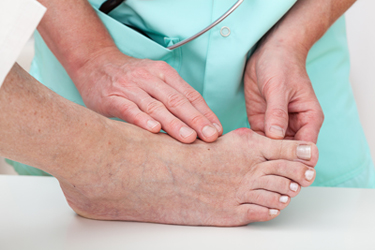
A bunion, termed hallux valgus, is a bone deformity of the big toe. This condition can cause the tip of the toe to push toward the smaller toes as the bottom of the toe joint juts outward from the foot. The resulting bump can prove to be painful as it changes the gait and rubs against the inside of the shoe. In some cases, a surgical procedure may be the only option for reducing pain. This may be successful in straightening out the joint, in addition to stabilizing the gait. It can also help to prevent hammertoe and other foot abnormalities from developing. Deciding on bunion surgery depends on various factors, such as the severity of the bunion, and whether it is related to osteoarthritis. Additionally, the impact it may have on completing daily activities or participating in sporting activities may contribute to making this decision. Side effects may include nerve damage, inflammation, and permanent stiffness. It is beneficial to explore this with a podiatrist before deciding on this type of surgery. To find out whether bunion surgery is the right option for you, it is suggested that you consult a podiatrist for an exam and diagnosis.
If you are suffering from bunion pain, contact one of our podiatrists of Westside Podiatry Center, LLP. Our doctors can provide the care you need to keep you pain-free and on your feet.
What Is a Bunion?
Bunions are painful bony bumps that usually develop on the inside of the foot at the joint of the big toe. As the deformity increases over time, it may become painful to walk and wear shoes. Women are more likely to exacerbate existing bunions since they often wear tight, narrow shoes that shift their toes together. Bunion pain can be relieved by wearing wider shoes with enough room for the toes.
Causes
- Genetics – some people inherit feet that are more prone to bunion development
- Inflammatory Conditions - rheumatoid arthritis and polio may cause bunion development
Symptoms
- Redness and inflammation
- Pain and tenderness
- Callus or corns on the bump
- Restricted motion in the big toe
In order to diagnose your bunion, your podiatrist may ask about your medical history, symptoms, and general health. Your doctor might also order an x-ray to take a closer look at your feet. Nonsurgical treatment options include orthotics, padding, icing, changes in footwear, and medication. If nonsurgical treatments don’t alleviate your bunion pain, surgery may be necessary.
If you have any questions, please feel free to contact one of our offices located in Liverpool, Camillus, Skaneateles, Oswego, and Cicero, NY . We offer the newest diagnostic and treatment technologies for all your foot care needs.
Wounds That Don't Heal Need to Be Checked
Causes and Treatment of Foot Blisters
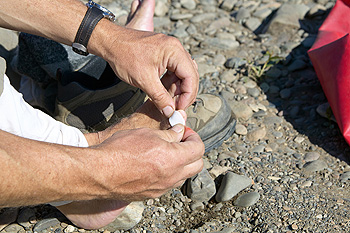
The most common cause of blisters on the foot is friction, usually between the foot and the shoe. Damage to the top skin layer can cause it to separate, leaving space for fluid to protect the underlying layers. Walking in tight shoes or wearing shoes without socks are common causes of friction blisters. They are nature’s way of protecting skin that is in danger of being damaged. Most friction blisters do not need medical attention, and if protected by a bandage, they will likely heal on their own in a few days. However, if a blister becomes infected, this may cause redness and swelling, and the blister may fill with pus or blood rather than a clear fluid. At this point, it is wise to seek medical help from a podiatrist, who can examine the blister and offer treatment options. Certain medications and protective bandages may be prescribed. It will also be beneficial to cease wearing the shoes that caused the blister to form. For further guidance, it is suggested that you consult a podiatrist.
Blisters are prone to making everyday activities extremely uncomfortable. If your feet are hurting, contact one of our podiatrists of Westside Podiatry Center, LLP. Our doctors can provide the care you need to keep you pain-free and on your feet.
Foot Blisters
Foot blisters develop as a result of constantly wearing tight or ill-fitting footwear. This happens due to the constant rubbing from the shoe, which can often lead to pain.
What Are Foot Blisters?
A foot blister is a small fluid-filled pocket that forms on the upper-most layer of the skin. Blisters are filled with clear fluid and can lead to blood drainage or pus if the area becomes infected.
How Do Blisters Form?
Blisters on the feet are often the result of constant friction of skin and material, usually by shoe rubbing. Walking in sandals, boots, or shoes that don’t fit properly for long periods of time can result in a blister. Having consistent foot moisture and humidity can easily lead to blister formation.
Prevention & Treatment
It is important to properly care for the affected area in order to prevent infection and ease the pain. Do not lance the blister and use a Band-Aid to provide pain relief. Also, be sure to keep your feet dry and wear proper fitting shoes. If you see blood or pus in a blister, seek assistance from a podiatrist.
If you have any questions, please feel free to contact one of our offices located in Liverpool, Camillus, Skaneateles, Oswego, and Cicero, NY . We offer the newest diagnostic and treatment technologies for all your foot care needs.
Running Revolves around the Right Pair of Shoes
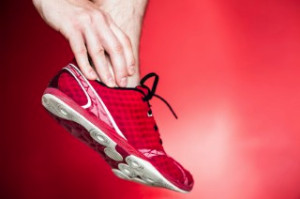 Whether you are a competitive or a casual runner, wearing the right pair of shoes is a key component of running. Finding the best shoes for your own personal needs revolves primarily around the shape and arch of your foot. Researchers from Runner’s World shared, “Flat feet tend to have fallen arches, making them flexible and prone to over-pronation, an inward rolling motion. Neutral feet are the most biomechanically sound variety, putting them somewhere in the middle. High-arched feet are essentially the polar opposite of flat feet. When the arches are particularly defined, the feet end up being rigid, leading to supination, or landing on the outside edges of the feet."
Whether you are a competitive or a casual runner, wearing the right pair of shoes is a key component of running. Finding the best shoes for your own personal needs revolves primarily around the shape and arch of your foot. Researchers from Runner’s World shared, “Flat feet tend to have fallen arches, making them flexible and prone to over-pronation, an inward rolling motion. Neutral feet are the most biomechanically sound variety, putting them somewhere in the middle. High-arched feet are essentially the polar opposite of flat feet. When the arches are particularly defined, the feet end up being rigid, leading to supination, or landing on the outside edges of the feet."
If you are a runner, wearing the right running shoe is essential. For more information, contact one of our podiatrists from Westside Podiatry Center, LLP. Our doctors can provide the care you need to keep you pain-free and on your feet.
Choosing the Right Running Shoe for Your Foot Type
To increase performance and avoid the risk of injury, it is important to choose the right running shoe based on your foot type. The general design of running shoes revolves around pronation, which is how the ankle rolls from outside to inside when the foot strikes the ground.
- Neutral runners are able to choose from a wide variety of shoes, including minimalist shoes or even going barefoot.
- Runners who overpronate, or experience an over-abundance of ankle rolling, should choose shoes that provide extra motion control and stability.
- Runners who underpronate, or supinate, have feet that have high arches and lack flexibility, preventing shock absorption. They require shoes with more flexibility and cushion.
If you have any questions please feel free to contact one of our offices located in Liverpool, Camillus, Skaneateles, Oswego, and Cicero, NY . We offer the newest diagnostic and treatment technologies for all your foot and ankle needs.
More...
Simple Stretching Methods to Prevent Foot Injuries
 Since feet are carrying the weight of the body all day, cramps are apt to occur especially after walking, standing, or during any type of vigorous exercise. While foot cramps are often unexpected, podiatrists suggest that sufferers stop the activity that caused the cramp and immediately stretch the foot. In a seated position, use your hands to hold your toes upwards to stretch the arches and hold for 30 seconds. Putting all of your body weight on one foot can also sufficiently stretch the cramped muscles and tendons in the feet. In addition to stretching, walking around on the cramped foot can help to release tension.
Since feet are carrying the weight of the body all day, cramps are apt to occur especially after walking, standing, or during any type of vigorous exercise. While foot cramps are often unexpected, podiatrists suggest that sufferers stop the activity that caused the cramp and immediately stretch the foot. In a seated position, use your hands to hold your toes upwards to stretch the arches and hold for 30 seconds. Putting all of your body weight on one foot can also sufficiently stretch the cramped muscles and tendons in the feet. In addition to stretching, walking around on the cramped foot can help to release tension.
Exercising your feet regularly with the proper foot wear is a great way to prevent injuries and build strength. If you have any concerns about your feet, contact one of our podiatrists from Westside Podiatry Center, LLP. Our doctors can provide the care you need to keep you pain-free and on your feet.
Exercise for Your Feet
Exercise for your feet can help you gain strength, mobility and flexibility in your feet. They say that strengthening your feet can be just as rewarding as strengthening another part of the body. Your feet are very important, and we often forget about them in our daily tasks. But it is because of our feet that are we able to get going and do what we need to. For those of us fortunate enough to not have any foot problems, it is an important gesture to take care of them to ensure good health in the long run.
Some foot health exercises can include ankle pumps, tip-toeing, toe rises, lifting off the floor doing reps and sets, and flexing the toes. It is best to speak with Our doctors to determine an appropriate regimen for your needs. Everyone’s needs and bodies are different, and the activities required to maintain strength in the feet vary from individual to individual.
Once you get into a routine of doing regular exercise, you may notice a difference in your feet and how strong they may become.
If you have any questions please feel free to contact one of our offices located in Liverpool, Camillus, Skaneateles, Oswego, and Cicero, NY . We offer the newest diagnostic and treatment technologies for all your foot and ankle needs.
Tarsal Tunnel Syndrome an Occupational Hazard
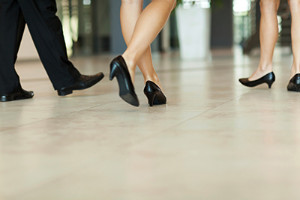 Injuries at work are unfortunate events that take place from time to time as a function of working conditions, occupation, and accidents. Causes of severe, acute injuries are usually relatively easy to identify. For example, if someone who uses knives during the course of the work day gets cut, it wouldn’t be too difficult to establish causality. However, for more chronic conditions, like tarsal tunnel syndrome, this may prove to be more difficult. Tarsal tunnel syndrome results when the tibial nerve in the tarsal tunnel is compressed. The symptoms may present themselves as a burning pain in the sole or tingling and numbness at the base of the foot. Repetitive motion of the ankle and the foot may lead to this. As certain occupations require these types of motions, employees may have a greater risk of getting tarsal tunnel syndrome.
Injuries at work are unfortunate events that take place from time to time as a function of working conditions, occupation, and accidents. Causes of severe, acute injuries are usually relatively easy to identify. For example, if someone who uses knives during the course of the work day gets cut, it wouldn’t be too difficult to establish causality. However, for more chronic conditions, like tarsal tunnel syndrome, this may prove to be more difficult. Tarsal tunnel syndrome results when the tibial nerve in the tarsal tunnel is compressed. The symptoms may present themselves as a burning pain in the sole or tingling and numbness at the base of the foot. Repetitive motion of the ankle and the foot may lead to this. As certain occupations require these types of motions, employees may have a greater risk of getting tarsal tunnel syndrome.
Tarsal tunnel syndrome can be very uncomfortable to live with. If you are experiencing tarsal tunnel syndrome, contact one of our podiatrists of Westside Podiatry Center, LLP. Our doctors can provide the care you need to keep you pain-free and on your feet.
Tarsal Tunnel Syndrome
Tarsal tunnel syndrome, which can also be called tibial nerve dysfunction, is an uncommon condition of misfiring peripheral nerves in the foot. The tibial nerve is the peripheral nerve in the leg responsible for sensation and movement of the foot and calf muscles. In tarsal tunnel syndrome, the tibial nerve is damaged, causing problems with movement and feeling in the foot of the affected leg.
Common Cause of Tarsal Tunnel Syndrome
- Involves pressure or an injury, direct pressure on the tibial nerve for an extended period of time, sometimes caused by other body structures close by or near the knee.
- Diseases that damage nerves, including diabetes, may cause tarsal tunnel syndrome.
- At times, tarsal tunnel syndrome can appear without an obvious cause in some cases.
The Effects of Tarsal Tunnel Syndrome
- Different sensations, an afflicted person may experience pain, tingling, burning or other unusual sensations in the foot of the affected leg.
- The foot muscles, toes and ankle become weaker, and curling your toes or flexing your foot can become difficult.
- If condition worsens, infections and ulcers may develop on the foot that is experiencing the syndrome.
A physical exam of the leg can help identify the presence of tarsal tunnel syndrome. Medical tests, such as a nerve biopsy, are also used to diagnose the condition. Patients may receive physical therapy and prescriptive medication. In extreme cases, some may require surgery.
If you have any questions please feel free to contact one of our offices located in Liverpool, Camillus, Skaneateles, Oswego, and Cicero, NY . We offer the newest diagnostic and treatment technologies for all your foot and ankle needs.
Study Shows Exercise May Help Arthritis
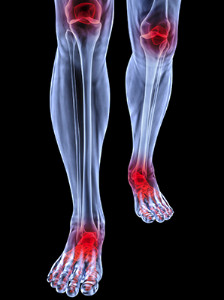 According to a Northwest University Study, even small amounts of exercise can have a positive impact on the health of those living with arthritis. The federal guidelines suggest that arthritic patients should practice “150 minutes of moderate activity per week,” and that this will help ease the pain and stiffness associated with the disease. The study, however, which consisted of 1600 adults aged 49 or older, showed that even subjects who did only 45 minutes of brisk walking a week were “80 percent more likely to improve or sustain physical function and gait speed.” If you are suffering from arthritis in the feet or anywhere else, a little walking may go a long way.
According to a Northwest University Study, even small amounts of exercise can have a positive impact on the health of those living with arthritis. The federal guidelines suggest that arthritic patients should practice “150 minutes of moderate activity per week,” and that this will help ease the pain and stiffness associated with the disease. The study, however, which consisted of 1600 adults aged 49 or older, showed that even subjects who did only 45 minutes of brisk walking a week were “80 percent more likely to improve or sustain physical function and gait speed.” If you are suffering from arthritis in the feet or anywhere else, a little walking may go a long way.
Arthritis can be a difficult condition to live with. If you are seeking treatment, contact one of our podiatrists from Westside Podiatry Center, LLP. Our doctors can provide the care you need to keep you pain-free and on your feet.
Arthritic Foot Care
Arthritis is a joint disorder that involves the inflammation of different joints in your body, such as those in your feet. Arthritis is often caused by a degenerative joint disease and causes mild to severe pain in all affected areas. In addition to this, swelling and stiffness in the affected joints can also be a common symptom of arthritis.
In many cases, wearing ill-fitting shoes can worsen the effects and pain of arthritis. Wearing shoes that have a lower heel and extra room can help your feet feel more comfortable. In cases of rheumatoid arthritis, the arch in your foot may become problematic. Buying shoes with proper arch support that contour to your feet can help immensely.
Alleviating Arthritic Pain
- Exercises that stretch the foot can prevent further pain and injury and increase mobility
- Most of the pain can be alleviated with anti-inflammatory drugs, heat, and topical medications
- Massages can help temporarily alleviate pain.
It is best to see your doctor for the treatment that is right for your needs and symptoms. Conditions vary, and a podiatrist can help you determine the right method of care for your feet.
If you have any questions, please feel free to contact one of our offices located in Liverpool, Camillus, Skaneateles, Oswego, and Cicero, NY . We offer the newest diagnostic tools and technology to treat your foot and ankle needs.
Biologic Drugs May Aid in Slowing Rheumatoid Arthritis
For those with rheumatoid arthritis, the risk of heart attacks is at least 60 percent higher than those without the condition “thought to be linked to the inflammation caused by the disease on affected joints.” As rheumatoid arthritis leads to the inflammation, swelling, and potential immobility of our body’s joints, there are several medical treatments such as biologic drugs that can be used to slow down the deterioration of the joints from this autoimmune disease. Researchers from the British Society for Rheumatology Biologics Register for Rheumatoid Arthritis (BSRBR-RA) conducted a study on rheumatoid arthritis patients, determining that tumor necrosis factor inhibitor (TNFi) drugs helped to eliminate the proteins that led to inflammation. These drugs reduced the risk of heart attacks by “almost 40 percent,” compared to those who were only taking synthetic disease modifying therapies (sDMARD), which are used to slow down the progression of deterioration of joints.
Because RA affects more than just your joints, including the joints in your feet and ankles, it is important to seek early diagnosis from your podiatrist if you feel like the pain in your feet might be caused by RA. For more information, contact one of our podiatrists of Westside Podiatry Center, LLP. Our doctors will assist you with all of your podiatric concerns.
What Is Rheumatoid Arthritis?
Rheumatoid Arthritis (RA) is an autoimmune disorder in which the body’s own immune system attacks the membranes surrounding the joints. Inflammation of the lining and eventually the destruction of the joint’s cartilage and bone occur, causing severe pain and immobility.
Rheumatoid Arthritis of the Feet
Although RA usually attacks multiple bones and joints throughout the entire body, almost 90 percent of cases result in pain in the foot or ankle area.
Symptoms
- Swelling and pain in the feet
- Stiffness in the feet
- Pain on the ball or sole of feet
- Joint shift and deformation
Diagnosis
Quick diagnosis of RA in the feet is important so that the podiatrist can treat the area effectively. Your doctor will ask you about your medical history, occupation, and lifestyle to determine the origin of the condition. Rheumatoid Factor tests help to determine if someone is affected by the disease.
If you have any questions please feel free to contact one of our offices located in Liverpool, Camillus, Skaneateles, Oswego, and Cicero, NY . We offer the newest diagnostic and treatment technologies for all your foot and ankle needs.


